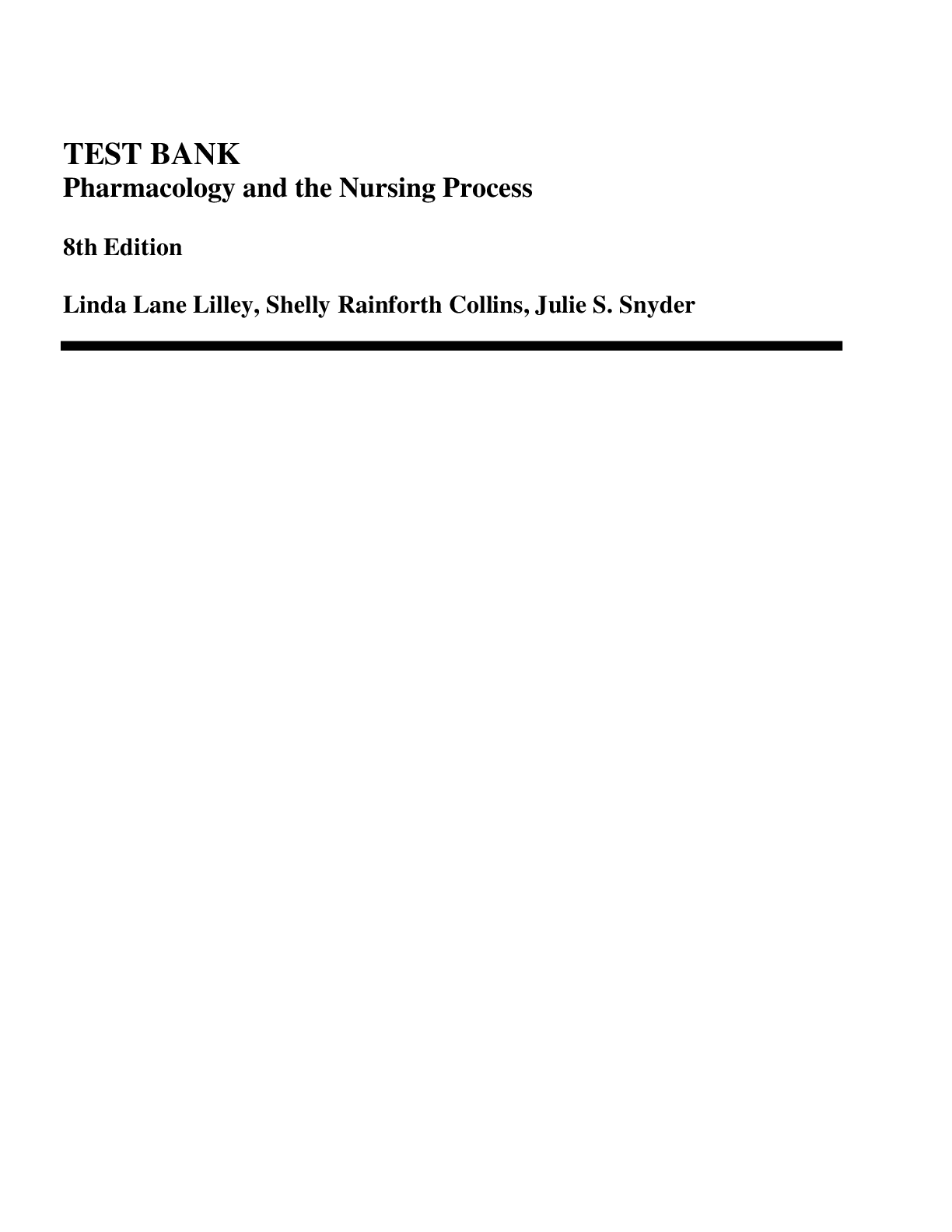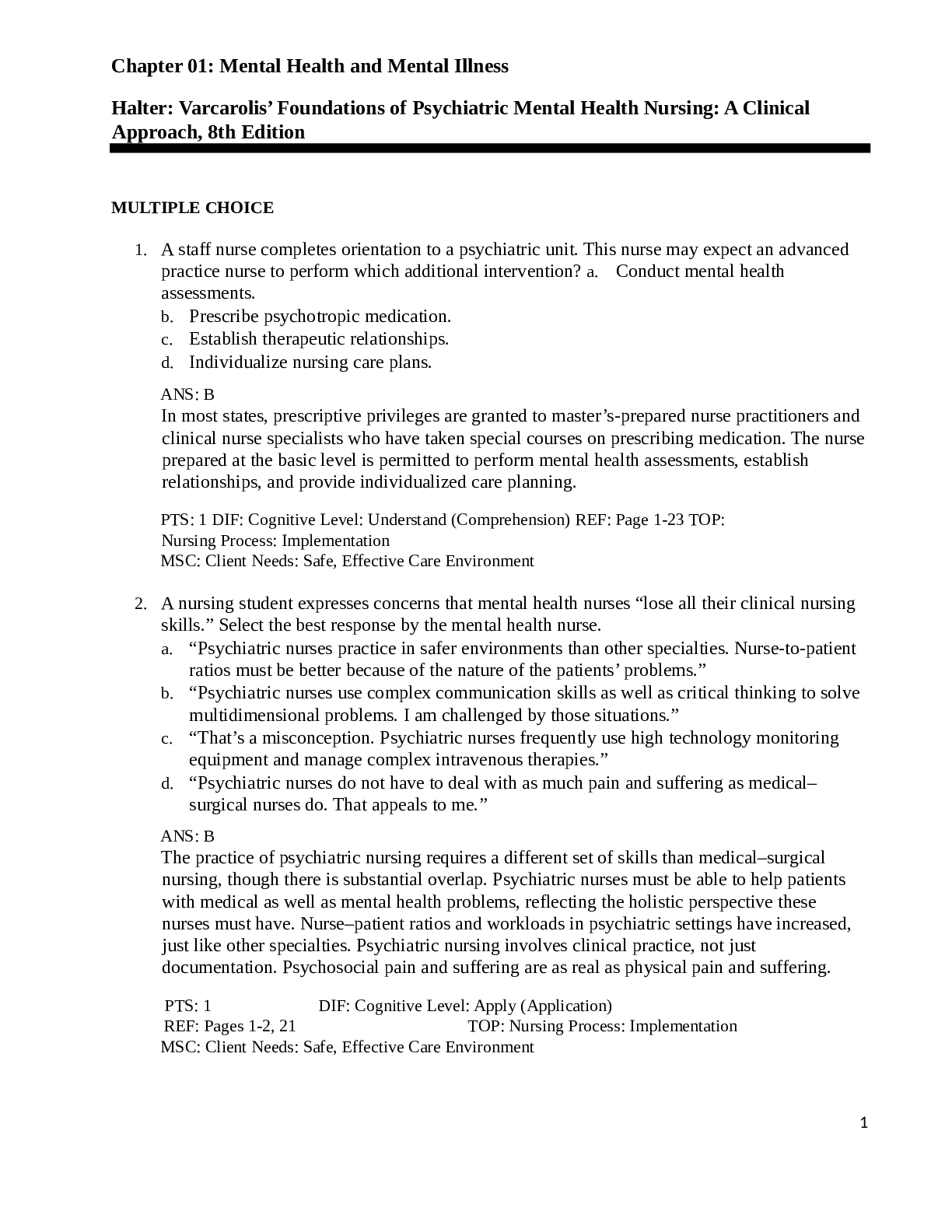TEST BANK CHAPTER 11: EYES
Document Content and Description Below
Chapter 11: Eyes MULTIPLE CHOICE 1.Contraction of which eye structure controls the amount of light that reaches the retina? a.Retina b.Iris c.Sclera d.Lens ANS: B The iris is able to dilate an... d contract, allowing light to reach the retina. The retina is deep within the eye and does not control the amount of entering light. The sclera is not able to dilate and contract. The lens is merely a transparent disc that acts as a focus for the retina. 2.Contraction or relaxation of the ciliary body: a.allows voluntary blinking. b.changes lens thickness. c.regulates peripheral vision. d.sends light impulses to the brain. ANS: B The lens is circularly supported by a framework of fibers from the ciliary body; contraction or relaxation of this structure results in a change in the thickness of the lens, allowing for accommodation as needed. 3.The sensory network of the eye is the: a.cornea. b.iris. c.pupil. d.retina. ANS: D The retina acts as the sensory network of the eye in that it sends electric impulses to the brain that are transformed from light. The cornea, iris, and pupil act together as an opening for light to pass through the lens. 4.Retinal hemorrhages in an infant require investigation for: a.retinoblastoma. b.retrolental fibroplasia. c.pituitary tumor. d.child abuse. ANS: D Beyond newborn age, any hemorrhages to the retina indicate infection, allergy, or trauma and should be further investigated. 5.An increased level of lysozyme in the tears will occur normally during which life stage? a.Adolescence b.Childhood c.Infancy d.Pregnancy ANS: D Because of rising hormone levels, an increased amount of lysozyme is present in tears during pregnancy. Tears are not affected by increased lysozyme at any other stage in life. TEST BANK CHAPTER 11: EYES 6.Tears flow over the cornea and drain via the lacrimal sac into the: a.anterior fossa. b.posterior pharynx. c.nasal meatus. d.thyroglossal duct. ANS: C Anatomically, the eye is closest to the nose, so tears drain from the lacrimal sac into the nasal lacrimal duct. 7.Mrs. Alden is a 29-year-old pregnant patient in her third trimester. She tells you that her vision has been a little blurred, and she thinks she needs to get new contact lenses. You should advise her to: a.get new lenses as soon as possible to avoid complications. b.wait until several weeks after delivery to get new lenses. c.go to the nearest emergency department for evaluation. d.change her diet to include more yellow vegetables. ANS: B Because of the increased level of lysozyme in the tears during pregnancy, a blurred sensation may occur but will subside several weeks after pregnancy. The blurred vision is a normal occurrence during pregnancy. It is not an emergency, nor is it diet-dependent. 8.Which of the following is a relatively benign condition that may occur during pregnancy or labor? a.Macular degeneration b.Papilledema c.Subconjunctival hemorrhage d.Cupping of the optic disc ANS: C Because of falling intraocular pressure during late stages of pregnancy, subconjunctival hemorrhages may occur and resolve spontaneously. Macular degeneration and cupping of the optic disc occur in older adults. Papilledema is never a benign condition. 9.When does the lens usually become more rigid while the ciliary muscle of the iris becomes weaker? a.At 25 years of age b.Around 35 years of age c.Around 45 years of age d.After 65 years of age ANS: C Starting at around 45 years of age, the lens starts to change and become more rigid, and the ciliary muscle begins to weaken. 10.A condition that typically develops by the age of 45 years is: a.presbyopia. b.hyperopia. c.myopia. d.astigmatism. ANS: A By 45 years of age, a condition known as presbyopia develops; presbyopia involves a weakening of accommodation. Hyperopia occurs in early infancy. Myopia and astigmatism can occur at any time. 11.Which of the following findings, when seen in the infant, is ominous? a.Difficulty tracking objects with the eyes b.Appearing to have better peripheral than central vision c.Blinking when bright light is directed at the face d.White pupils on photographs ANS: D The absence of a red reflex, determined by physical examination or the appearance of white pupils on a photograph, is indicative of retinoblastoma, a serious retinal tumor. 12.The Rosenbaum card is used to measure: a.distance perception. b.near vision. c.peripheral distortion. d.the ability to identify colors. ANS: B The Rosenbaum card is best used to measure nearsightedness because the patient holds the card at a comfortable distance and reads from the card. The Rosenbaum card is not used to measure distance perception because distance perception cannot be accurately measured with a card held close to the patient. Peripheral vision is assessed by an examiner with hand movements. Color identification can be measured with color cards. 13.When measuring visual acuity, you are assessing cranial nerve: a.I. b.II. c.IV. d.VI. ANS: B Visual acuity is controlled by cranial nerve II. Cranial nerve I deals with the sense of smell. Cranial nerve IV deals with accommodation. Cranial nerve VI deals with lateral eye muscle movements. 14.Measurement of near vision should be done: a.in each eye separately. b.with the head at a 45-degree angle. c.with the use of primary colors. d.with the use of the Snellen chart. ANS: A Near vision is measured with the Rosenbaum card and should be tested in each eye separately, with the patient holding the card in front of her or him at about 35 cm. 15.Mr. C’s visual acuity is 20/50. This means that he: a.can see 50% of what the average person sees at 20 feet. b.has perfect vision when tested at 50 feet. c.can see 20% of the letters on the chart’s 20/50 line. d.can read letters while standing 20 feet from the chart that the average person could read at 50 feet. ANS: D Visual acuity is measured as a fraction, in which the top number is the distance that the patient is standing from the chart; the bottom number is the distance that an average person can stand and still read the line. 16.Peripheral vision can be estimated by means of which test? a.Confrontation b.Pupillary reaction c.Accommodation d.Snellen E chart ANS: A The confrontation test measures peripheral vision. The examiner sits or stands across from the patient and asks the patient to close one eye while the examiner closes the opposite eye. The examiner then proceeds to wave the fingers while moving the extended arms from a lateral to a central position along both the temporal and the nasal fields. The pupillary reaction test is done to observe the pupil’s response to light. The accommodation test deals with the pupils’ reaction to light. The Snellen E chart is used to measure visual acuity. 17.The criterion for determining the adequacy of a patient’s visual field is: a.the ability to discriminate primary colors. b.the ability to discriminate details. c.correspondence with the visual field of the examiner. d.distance vision equal to that of an average person. ANS: C The examiner compares his or her own peripheral vision to that of the patient while performing the confrontation test, so unless the examiner is aware of a problem with his or her own vision, the examiner could assume that the fields are full if they match. 18.Periorbital edema is: a.a sign of abnormality. b.expected with aging. c.more common in males. d.present in children. ANS: A A clinical finding of periorbital edema should always be regarded as an abnormal finding until ruled otherwise. 19.Xanthelasma may suggest that the patient has an abnormality of: a.lipid metabolism. b.cognitive function. c.renal metabolism. d.bone marrow function. ANS: A Small, odd-shaped, yellow-colored plaques around the eyes—called xanthelasma—are actually lipid deposits and are characteristic of a lipid metabolism problem. 20.Mrs. S. is a 69-year-old woman who presents for a physical examination. On inspection of her eyes, you note that the left upper eyelid droops, covering more of the iris than does the right. This is recorded as: a.exophthalmos on the right. b.ptosis on the left. c.nystagmus on the left. d.astigmatism on the right. ANS: B Ptosis is when one of the upper eyelids covers more of the iris than the other lid, possibly extending over the pupil. 21.Ptosis may be secondary to: a.paresis of a branch of cranial nerve III. b.hyperthyroidism. c.psoriasis. d.blepharitis. ANS: A Ptosis is caused by a congenital defect of the muscle around the eye controlled by cranial nerve III. Hyperthyroidism causes exophthalmos. Psoriasis is a skin condition. Blepharitis is inflammation of the eyelid. 22.What is the name of the condition in which the eyelid is turned away, or everted, from the globe? a.Ectropion b.Entropion c.Exophthalmos d.Ptosis ANS: A Ectropion describes an everted lower lid that is turned away from the eye. Entropion describes the lower lid turning inward. Exophthalmos describes the bulging of the eye globe. Ptosis refers to a drooping of the upper eyelid. 23.Entropion implies that the lower eyelid is: a.drooping. b.everted. c.edematous. d.turned inward. ANS: D Entropion involves a slight inward turn of the lower eyelid. 24.A condition in which the eyelids do not completely meet to cover the globe is called: a.glaucoma. b.lagophthalmos. c.exophthalmos. d.hordeolum. ANS: B Lagophthalmos is a term used to describe the condition in which eyelids do not completely meet when closing. Glaucoma involves elevated pressure in the eye. Exophthalmus involves bulging eyes. A hordeolum is better known as a stye. 25.Inspection of the tarsal conjunctiva should be performed: a.with every eye examination. b.in eye examinations in patients older than 45 years. c.when a foreign body may be present. d.for the patient with glaucoma. ANS: C Inspecting the tarsal conjunctiva involves pulling the top eyelid down and up while everting the lid. This maneuver is reserved for inspecting for the presence of a foreign body. 26.Mr. Morris is a 38-year-old patient who presents to the clinic with complaints of allergies. An allergy can cause the conjunctiva to have a: a.cobblestone pattern. b.dry surface. c.subconjunctival hemorrhage. d.rust-colored pigment. ANS: A A red or cobblestone pattern, especially to the upper conjunctiva, indicates allergic conjunctivitis. Allergies also cause itchy, watery eyes rather than dry surfaces, hemorrhage, or rust-colored pigment. 27.An abnormal growth of conjunctiva extending over the cornea from the limbus is known as: a.a cataract. b.erythematous. c.glaucoma. d.a pterygium. ANS: D An abnormal growth of the conjunctiva that extends over the cornea is called a pterygium. Cataracts and glaucoma do not affect the conjunctiva. Erythematous means that the area is red and irritated. 28.A pterygium is more common in people heavily exposed to: a.high altitudes. b.tuberculosis. c.ultraviolet light. d.cigarette smoke. ANS: C Persons heavily exposed to ultraviolet light are more susceptible to the development of a pterygium. 29.Mr. Brown was admitted from the emergency department, and you are completing his physical examination. His pupils are 2 mm bilaterally, and you notice that they fail to dilate when the penlight is moved away. This is characteristic in patients who are or have been: a.in a coma. b.taking sympathomimetic drugs (cocaine). c.taking opioid drugs (morphine). d.treated for head trauma. ANS: C Pupil constriction to less than 2 mm is called miosis. With miosis, the pupils fail to dilate in the dark, a common result of opioid ingestion or the use of drops for glaucoma. Pupils are usually dilated greater than 6 mm in a patient described in the other choices. 30.When testing corneal sensitivity controlled by cranial nerve V, you should expect the patient to respond by: a.brisk blinking. b.copious tearing. c.pupil dilation. d.reflex smiling. ANS: A Brisk blinking is an expected response to corneal sensitivity testing, which involves gently touching the cornea with a piece of cotton. 31.You observe pupillary response as the patient looks at a distant object and then at an object held 10 cm from the bridge of the nose. You are assessing for: a.confrontation reaction. b.accommodation. c.pupillary light reflex. d.nystagmus. ANS: B Testing for accommodation involves asking the patient to look at an object at a distance (pupils dilate) and then to look at another, much closer object (pupils constrict). 32.Mydriasis is an accompaniment of: a.coma. b.diabetes. c.hyperopia. d.astigmatism. ANS: A [Show More]
Last updated: 2 years ago
Preview 1 out of 12 pages

Buy this document to get the full access instantly
Instant Download Access after purchase
Buy NowInstant download
We Accept:

Reviews( 0 )
$13.00
Can't find what you want? Try our AI powered Search
Document information
Connected school, study & course
About the document
Uploaded On
May 12, 2022
Number of pages
12
Written in
Additional information
This document has been written for:
Uploaded
May 12, 2022
Downloads
0
Views
76








_compressed.png)





